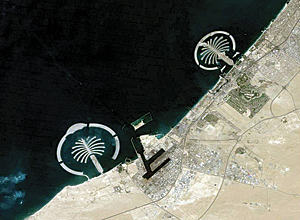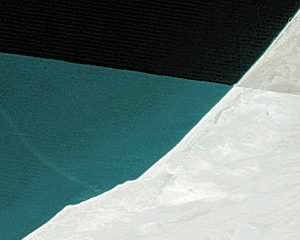Happy Anniversary, Landsat!
Landsat Provides the Longest Continuous Data of Our Changing World
1972 was an exciting year. The Rolling Stones were the number-one band, Bobby Fischer became the world chess champion, and the Dow Jones Industrial Average closed above 1,000 for the first time. At the US Geological Survey (USGS) and the National Aeronautics and Space Administration (NASA), a group of forward-looking engineers and scientists were preparing to launch the first spacecraft designed to monitor and report the earth's resources through remote sensing, Landsat 1. On July 23, 1972, they successfully launched the craft.
On the 40th anniversary of the first Landsat launch, Esri would like to take a moment to reflect on the significance the Landsat program has had on global research and understanding. Landsat data remains one of the best ways to visualize and analyze earth changes because of the coverage, quality, and length of time this data has been collected. In fact, Landsat data provides the longest continuous record of earth changes as seen from space. The Landsat program provides access to the data people need to undertake serious projects that affect all of us, including environmental change mitigation and land-use planning, deforestation, natural disasters, and pollution. It is used to understand and monitor our freshwater supplies and evaluate agricultural productivity and is detailed enough to witness the effects of urban growth. In addition, Landsat data provides a window in time for young people to see how the earth around them has changed over their parents' lives and their own. This gives them a great perspective on the effect we have on nature.
The earth is constantly changing, and for the last 40 years, Landsat imagery has made it possible for people worldwide to study, question, and investigate the changes around them. 2008 marked a turning point in the use of Landsat, when Secretary of the Interior Dirk Kempthorne announced that all the Landsat data in the USGS archive would be free to the public by the end of the year. People worldwide are trying to solve complex environmental challenges, and fast and easy access to Landsat data, without fiscal constraints, has made a tremendous difference. This has opened the data usage to academic institutions, field researchers, and scientists that may not have had the ability to purchase Landsat data previously.
Congratulations, USGS and NASA, on over 40 years of successful missions! The future for Landsat looks promising, with the Landsat Data Continuity Mission in the final phases of design and fabrication and the launch scheduled for January 2013. With all the technical advances, two new spectral bands, improvements in technology and performance, and probability of capturing more cloud-free scenes, Landsat is not only getting better with age but looks better too. Happy anniversary!
Related Podcast
The View from Space
Dr. Einar Bjorgo, head of rapid mapping, applications, and user relations with the United Nations Institute for Training and Research, discusses the importance of satellite imagery in international aid work. Listen to the podcast. [19:00 | 18 MB]

